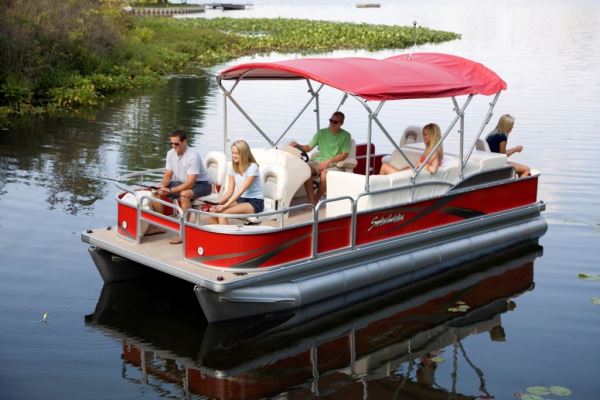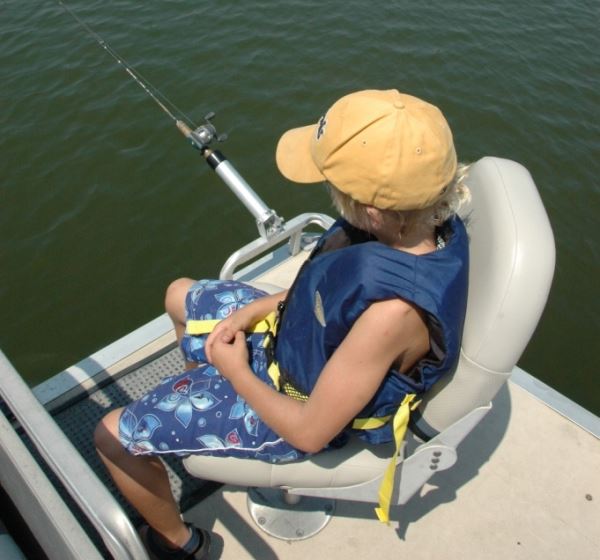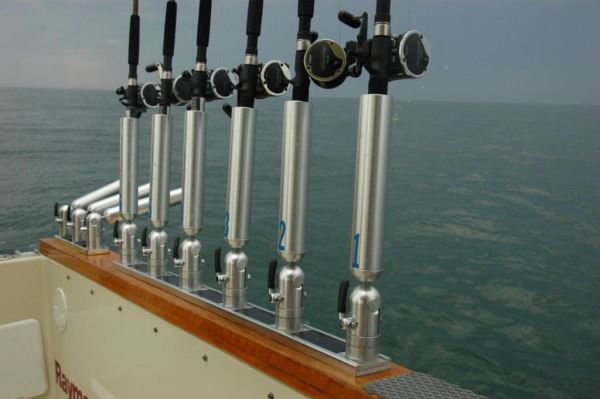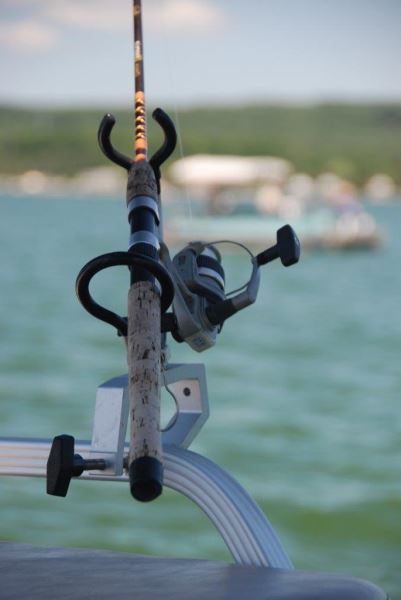
“What do we need if we want to try fishing from our boat?” is a question I get asked, in one form or another, on a regular basis by boat owners who use their craft for cruising or watersports other than fishing. Whether it’s by fellow pontoon boat club members locally, who see us returning to the dock with a day’s catch, or by folks who know that I write about angling from pontoon boats, it seems that more people than ever—and that includes owners of pontoon and deck boats—want to give fishing a try. In fact, more pontoon boat owners than any other category of boaters seem to want to know how to wet a line from their craft.
 Perhaps it’s because they recognize the advantages of angling from boats that are obviously “fishing friendly,” offering the stability and deck space that drew many of us to consider a pontoon boat in the first place. I also can’t help but think that in some instances it also may be the performance limitations that the design places on owners who want to pursue more active tow sports. Although huge advances have been made to enhance pontoon performance, the handling characteristic of deck boats and other modern mono-hulled craft make them better choices for boaters who want to enjoy more active watersports. Pontoon owners don’t mind that their boats may not leap to plane on a hole shot, turn on a dime or leave a radical wake for jumping; there are plenty of reasons we prefer our breed of boats, and fishing should be high on the “pro” column for pontoons when weighing activity options offered by all types of watercraft.
Perhaps it’s because they recognize the advantages of angling from boats that are obviously “fishing friendly,” offering the stability and deck space that drew many of us to consider a pontoon boat in the first place. I also can’t help but think that in some instances it also may be the performance limitations that the design places on owners who want to pursue more active tow sports. Although huge advances have been made to enhance pontoon performance, the handling characteristic of deck boats and other modern mono-hulled craft make them better choices for boaters who want to enjoy more active watersports. Pontoon owners don’t mind that their boats may not leap to plane on a hole shot, turn on a dime or leave a radical wake for jumping; there are plenty of reasons we prefer our breed of boats, and fishing should be high on the “pro” column for pontoons when weighing activity options offered by all types of watercraft.
So what do you need to outfit your boat for occasional fishing? First of all, you need fishing tackle: rod and reels and lures. I’m going to leave that subject for another day and assume you or the guests you plan on welcoming aboard to wet a line have the fishing tackle you intend to use. Other than that, the number one item I recommend to make your pontoon or deck boat into an effective fishing platform is a rod holder—or three.
 And we’re talking rod holders, for use while fishing, not rod racks, for storage. Rod holders are devices that attach to the boat’s rail, gunwale or deck that hold a fishing rod’s butt section while pointing the tip out over the water—or at least up into the air—keeping the rod and reel accessible to the angler, yet out of the way and not poking passengers or getting stepped on. Again, rod holders are designed to be used while fishing, and most aftermarket rod holders are portable and adjustable, so you can position the tip of the rod out over water or point it back toward the stern, depending on where you want your bait to be. Rod holders are especially welcome when you have youngsters aboard who want to “fish” but may not be patient enough to hold the rod for more than a few minutes at a time.
And we’re talking rod holders, for use while fishing, not rod racks, for storage. Rod holders are devices that attach to the boat’s rail, gunwale or deck that hold a fishing rod’s butt section while pointing the tip out over the water—or at least up into the air—keeping the rod and reel accessible to the angler, yet out of the way and not poking passengers or getting stepped on. Again, rod holders are designed to be used while fishing, and most aftermarket rod holders are portable and adjustable, so you can position the tip of the rod out over water or point it back toward the stern, depending on where you want your bait to be. Rod holders are especially welcome when you have youngsters aboard who want to “fish” but may not be patient enough to hold the rod for more than a few minutes at a time.
.JPG_600.jpg) There are two categories of rod holders, flush mount and surface mount. Flush-mount rod holders are permanent and not adjustable; tube-shaped and angled, and they are sunk level with the deck or gunwale to hold the rod and reel by the rod butt. Most factory-installed rod holders are flush mounts, and are made of metal or plastic. The advantage of flush-mount rod holders is that they are always available yet never in the way. They also can be used to secure other items such as cup holders, grills, and small food prep and cutting boards. You can install flush mounts in aftermarket applications using a hole saw, silicone and sheet metal screws—as long as you have a level surface and space below to accommodate it.
There are two categories of rod holders, flush mount and surface mount. Flush-mount rod holders are permanent and not adjustable; tube-shaped and angled, and they are sunk level with the deck or gunwale to hold the rod and reel by the rod butt. Most factory-installed rod holders are flush mounts, and are made of metal or plastic. The advantage of flush-mount rod holders is that they are always available yet never in the way. They also can be used to secure other items such as cup holders, grills, and small food prep and cutting boards. You can install flush mounts in aftermarket applications using a hole saw, silicone and sheet metal screws—as long as you have a level surface and space below to accommodate it.
For most aftermarket applications, I recommend surface-mounted rod holders, which rely on mounts that clamp to a rail or are attached to a vertical or horizontal surface along the boat’s gunwale. I like Roberts-style rod holders; they are adjustable and portable, and offered with a wide variety of mounting options for rails, horizontal or vertical surfaces. Robert’s style mounts may be completely portable clamp-on styles for use on round or rectangular rails, or use bases of a semi-permanent nature, secured with screws or bolts, which remain in place while the bulkier holders themselves can be stowed when not in use. Cabela’s, Scotty, Attwood, West Marine as well as most marine suppliers offer their own style of Robert’s-style rod holders. Other types of fully-adjustable portable or semi-portable surface-mount rod holders are also available from sources such as Drift Master and Tite-Lok that do an excellent job as well.
 The key is selecting a rod holder that will mount on your boat where you want it and will remain secure enough to hold the rod and reel in the event a large fish hits the bait and starts pulling on the line while the rig is in the holder. While most fishing will be done with the angler actually holding the rod and reel, casting and retrieving the bait, some fishing tactics such as trolling or still fishing allow the angler to place the rod and reel in the holder to do the holding while waiting for a fish to strike. Some cheap clamp-on models can loosen with boat vibration alone—let alone surrendering a rod and reel to the first tug of a fish—so no matter what holder you install, test it to make sure it will stay securely in place before using it. Most will serve to secure the rod and reel, while the boat is underway to and from the fishing grounds as well as being there when an angler needs and extra hand, or to hold the rod when trolling, drifting or still fishing.
The key is selecting a rod holder that will mount on your boat where you want it and will remain secure enough to hold the rod and reel in the event a large fish hits the bait and starts pulling on the line while the rig is in the holder. While most fishing will be done with the angler actually holding the rod and reel, casting and retrieving the bait, some fishing tactics such as trolling or still fishing allow the angler to place the rod and reel in the holder to do the holding while waiting for a fish to strike. Some cheap clamp-on models can loosen with boat vibration alone—let alone surrendering a rod and reel to the first tug of a fish—so no matter what holder you install, test it to make sure it will stay securely in place before using it. Most will serve to secure the rod and reel, while the boat is underway to and from the fishing grounds as well as being there when an angler needs and extra hand, or to hold the rod when trolling, drifting or still fishing.
With rod holders, anglers aboard your pontoon or deck boat have a secure place to put their rod and reel when they fish or need a break from holding their rigs, and are the best accessory you can add to adapt your boat for angling—occasionally or otherwise.

